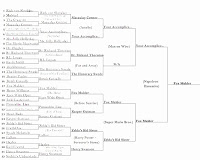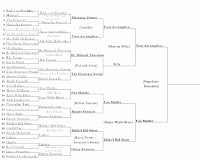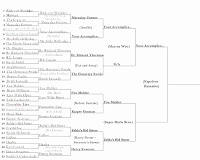What an interesting battle! Hayley had a strong lead, but suddenly Karl Freund jumped up out of nowhere and caught up. But in the end, Hayley still kept her lead and won the round. Congrats! Just a couple more battles before the end of the round, guys and gals! And we’ll finally be able to move on–which word on the street has it is a reason voting has sunk lately (taking too long). But for this next battle, we’re looking at another classic musical, Singin’ in the Rain. Read, vote, comment, enjoy! You have until Tuesday. Below is the updated bracket. Click to make it bigger.
——————————–
Review #1
By Henry Swanson
I signed up for this review tournament because I figured it would be a fun thing to do. Since I knew the films were going to range in dates from the ’20s to the present, I was all but certain I’d be in for some new movie-watching experiences. Well, it didn’t take long for that to happen. I haven’t watched a lot of musicals, and as of last night, none that were made before the ’70s. But after watching Singin’ in the Rain, I feel like a whole new genre – and a brand-new set of stars – have opened up to me. Gene Kelly and company forged a mighty musical in Singin’ in the Rain, and it still entertains 60 (!) years after its creation.
I was actually kind of apprehensive about watching this. I didn’t know what to expect, and, as I mentioned, my exposure to musicals is limited. From the few I have seen, one thing seems to stand out in my mind: comedy. I tend to enjoy musicals a lot more if they’re funny. Honestly, I didn’t think Singin’ in the Rain would make me laugh, but it did. A lot. Donald O’Connor’s Cosmo had a lot to do with that, but the overall tone of the film was playful and didn’t take itself too seriously. Case in point, near the beginning of the film, Gene Kelly’s character, Don Lockwood, is talking about how he got into the movie business. He was a stunt man for a bunch of pictures, and it showed him doing all kinds of crazy ridiculous things like flying a plane into a building, running into a shack full of dynamite right before it explodes, and just generally getting the shit kicked out of him by Hollywood. Hey, he seemed happy about it, so whatever floats your boat, there, Gene.
Speaking of Gene Kelly, I’m pretty sure…wait, yea…I know I want to be him. Not now, because he’s dead, but at least him during the filming of Singin’ in the Rain. I’d never seen one of his films before, and holy shit, that man is impressive. Name me a modern leading man who does all the acting, all the dancing, all the singing, all the stunts, and all the choreography himself. Name me one who can do all those things as well as Gene Kelly, and I’ll send you a cookie in the mail. Tom Cruise comes to mind because he does mostly all of his own stunts, but he probably can’t sing, and I don’t think him dressing up in a fat suit and bouncing around with Jennifer Lopez counts as a dancing career. Anyways, back to Gene Kelly. I read he was hard to work with because he was such a perfectionist, but his dedication shows, and you know what? He has to be in immaculate shape to pull off even half of the shit he does in this film. He could probably choke out Arnold with a simple leg lock.

Since I just discussed one of the best things about Singin’ in the Rain, let’s move on to one of the worst. Worse by design, but still. Yea, Lina Lamont, that bitch. Jean Hagan did an excellent job of making me hate a female character almost as much as I hate Kate Capshaw in Indiana Jones and the Temple of Doom. Almost. Lina Lamont is an utterly useless person, and despite Lockwood saying exactly that to her face multiple times, she still couldn’t get it through her thick skull. Everything is always about her. She’s the star of the pictures; without her everyone else is nothing; blah blah, boo hoo. When characters like that get their comeuppance, I swear to god it makes my day. And what a comeuppance she got. There’s nothing like getting publicly ridiculed for your nails-on-a-chalkboard voice and personality to match. If you haven’t seen this film, you should. Watching her get shit on is one of the small joys in life.

Did you know that in the iconic scene where the film gets its name, the rain pouring down on Gene Kelly is actually a mixture of water and milk? Now you do. Apparently, it showed up on camera much better with the added milk. Huh. But that’s not the most bizarre thing in Singin’ in the Rain. No, that honor goes to another dance and song routine. There’s a part in the film where Lockwood is explaining the last dance number they need to shoot for their first talkie. The screen fades out, and it basically shows the routine that’s in his head as he explains it. That’s fine, except I wouldn’t exactly call it a dance routine. It’s more along the lines of a Gene Kelly acid trip, and I had no idea what the hell was going on. There’s even some kind of dream sequence within the routine in his head, and that shit made even less sense. All of a sudden, I was watching Inception in the Rain. I really could have done without that whole thing. I mean, the actual songs were good, and the sets were gorgeous. The one involving red steps and a long, see-through scarf was a particular visual treat. The problem, though, is that it took up something like 15 minutes. For me, that was too long. Every other musical number in the film takes place alongside the story, whereas this one really hindered the narrative. On the other hand, the peyote was strong, so that’s cool, man.

Aside from the acid flashback, I thoroughly enjoyed the musical numbers. Off the top of my head, I’d say my favorites were Moses Supposes, Singin’ in the Rain, and Make ’em Laugh, the latter showcasing some of the funniest moves in the film. Donald O’Connor plays Cosmo Brown, Lockwood’s friend and professional partner. He’s also an insanely gifted, physical actor, and his stunts elicited a lot of laughter from of me. In Make ’em Laugh, he finishes the routine by backflipping off of two walls, and jumping through another. I marked that down in my notepad as a win.
I can’t believe I hadn’t seen this until now. I pride myself on the fact that I’ll watch any kind of movie, so it’s nice to know there’s still a whole unexplored genre out there for me to discover. As for Singin’ in the Rain, Kelly and O’Connor’s physicality plus a genuinely engrossing story to go along with all the excellent songs makes for a timeless piece of entertainment. Also, I now have a giant crush on Debbie Reynolds.
—————————-
Review #2
By Sorkin’s Understudy
Strict contemporary film watchers and musical cynics DON’T beware. Many contemporaries have often imitated the delightfully joyous and fancy-free moments of the 1952 film Singin’ in the Rain but they can never really be duplicated.
Picture it. Hollywood. 1927. Silent movies are on the way out to make way for talkies, but a few are attempting to hang on to the glory. We, as the viewers, are invited to the preview of The Royal Rascal, the latest silent film showcasing Hollywood’s supercouple – the stately Don Lockwood (Gene Kelly) and the dim-witted, self-absorbed Lina Lamont (Jean Hagen) (Don-ina? Li-on? Lockamont?). Similarly, we get a glimpse into Don and Lina’s dysfunctional working relationship, Lina’s delusions that their trumped up tabloid relationship is real, and her constant clashes with Don’s childhood best friend and production musician Cosmo Brown (Donald O’Connor). Lina is the kind of girl with a bad attitude and a sense of entitlement that can often lead to trouble, but it Don that provides that balance and continually keeps her in check.
It is one day when Don is running away from rabid fans that he physically jumps in a passing car (impressively, I might add) driven by Kathy Selden (Debbie Reynolds), a slightly neurotic yet lovable young wannabe actress. While Lina indulges his celebrity persona, Kathy brings him down to earth and treats him like a regular guy. Kathy doesn’t easily fall for Don’s charms; she challenges him at every turn, and he grows to appreciate her for it. It’s the little moments between the actors that make their connection believable – the look on his face when he watches her dance as part of the entertainment at a Hollywood party, the smiles they share on their stroll around the movie lot, their first dance together on the soundstage. And while Lina continues to attempt to win over Don’s affections, we watch as he falls madly in love with Kathy instead.
As the Lockwood/Lamont film production The Dueling Cavalier is facing financial ruin as its release is in position to compete with the new talkie The Jazz Singer, the studio decides to convert the picture into a talking one. Production proves disastrous, especially with the issue of Lina’s high-pitched, grating voice that was well hidden by her silent film roles but now threatens to be exposed. Kathy and Cosmo suggests that the entire film is re-imagined as a singling and dancing production. Great idea, kids, but there’s a problem; Lina can’t sing or dance (and can barely enunciate). Taking it even further, Cosmo proposes that Kathy voice is dubbed for Lina’s without her knowledge to circumvent the speaking/singing issue. Through the development of this new vision that is ultimately a success, jealousies between Lina and Kathy threatens the film’s success and the careers of all involved; Lina, discovering that Kathy will be given onscreen credit for her part in the deception, threatens to sue the studio. To teach Lina a lesson, the gang exposes her as a fraud in front of the premiere audience when she decides to give the post-viewing speech she has always wanted to give and the audience convinces her to sing for them.
The highlights of the film are definitely within the musical performances. Donald O’Connor mesmerizes in the first big musical number “Make ‘em Laugh”, meant to cheer up the lovelorn Don. The sequence beautifully combines physical comedy and rich, boastful vocals; He hams it up on the screen and its oh so fun to watch. The ultimate bromance of Don and Cosmo culminates in the form of the tap number “Moses Supposes” during a session Don has with his vocal coach. Though the two men couldn’t be more different – Gene Kelly is so much the smooth operator and Donald O’Connor the goofball – but they blend their personalities in perfect dance harmony. We witness the magical combination of leading man, spunky and sweet ingenue, and wacky sidekick/wingman, when they share the screen for “Good Mornin’”. And later, Gene Kelly breaks into the greatest singular moment of the film, the film’s namesake “Singin’ in the Rain”. His feet glides smoothly across sidewalks as it rains around him, and he splashes around in puddles with childlike blissfulness of a man in love.
Anyone watching can tell that the musical and dance numbers of the film of heartfelt endeavors, not showy with a feeling of being staged. They come naturally to those executing them and are infused with their genuine personalities. These three-dimensional characters live and breathe on film, don’t hide any part of themselves from us, and interact so effortlessly that we are drawn in. When they dance and sing, we don’t wonder why they are doing so. They story moves them to, and we understand the encouragement. While Gene Kelly (and all his masculine glory) may have been the big draw for the film, O’Connor and Reynolds make their presence known. The film is not without its weaker moments; there are a couple of overblown, over-the-top dance sequences of “Broadway Melody” meant to elevate the re-envisioned film (aptly renamedThe Dancing Chevalier) but only seems out of place in the genuine world the movie creates, however what Singing in the Rain has accomplished is elevating expectations of musicals that came after it in terms of performance.
The staying power of Singin’ in the Rain is evident by its continued infusion into contemporary pop culture, even in the last few years from Joseph Gordon-Levitt’s rendition of the “Make ‘em Laugh” in his opening monologue for SNL to the Gene Kelly-esque incorproation of “Singin’ in the Rain” in a mashup on Glee. Even some plot points at the beginning of the film bare a striking resemblance to that of The Artist and could have served as an inspiration for that film. What this teaches us is that these songs, these film moments are timeless.
So Happy 60th anniversary to you, Singin’ in the Rain. I never would have thought I would have enjoyed you so much. Your infectious charm will be around for many more years to come.
——————-
Now Vote!











This is my favorite movie, and I am SO HAPPY that both reviewers appreciated it. Henry Swanson, thank you so much for loving it and for feeling that you’ve found a new genre to enjoy. You truly do. I recommend American in Paris next, or On the Town. You want more after that, just let me know.
Sadly, I could only vote for one review, and I chose Sorkin’s Understudy, whose review was slightly better written (albeit in need of some proofreading).
Again, so very happy that you both enjoyed this film. If I could make everyone in the world watch one movie, it would be this one.
This was the first review where I think I guessed the identity of one of the writers. Both good reviews, I’m looking orward to watching this film now I know a little more about it!
Another two pretty great reviews. It was nice hearing Henry’s newness to musicals come out, but he completely neglected to mention the character Kathy at all. I also thought the use of language seemed disjointed to the type of movie it is. I also thought the trivia about the rain was fairly random and didn’t really contribute to the review at all.
Sorkin’s Understudy had a real love of the film, and I could tell throughout the review which was nice to see. My only problem with it is that I think there was a little too much detail about the plot, as it seemed to cover more or less the entire movie. But I still enjoyed the review a little bit more, so that’s who got my vote.